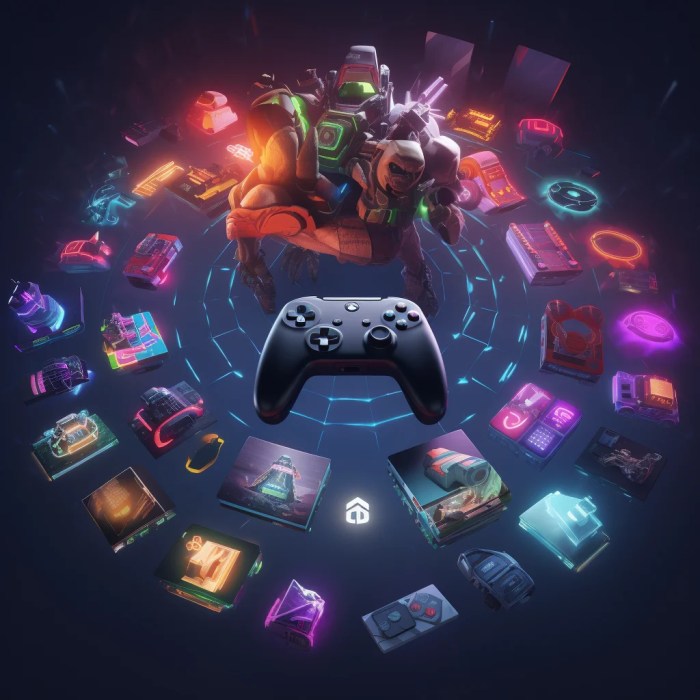Gaming Platforms: From Pong to PlayStation 5, the evolution of how we play games is wild! This deep dive explores the history, technology, market forces, and social impact of everything from classic arcades to cutting-edge VR. We’ll unpack the different platforms – consoles, PCs, mobile, the whole shebang – and how they’ve shaped gaming culture. Get ready for a seriously fun ride!
We’ll cover the major players, analyze market trends, and even peek into the future of gaming. Think mind-blowing graphics, AI-powered opponents, and game-changing tech that’s just around the corner. We’ll look at the business side of things, too, from revenue models to the economic impact of esports. It’s gonna be epic.
Gaming Platform Market Analysis

The gaming platform market is a dynamic and fiercely competitive landscape, constantly evolving with technological advancements and shifting consumer preferences. Understanding the major players, their market share, and the strengths and weaknesses of their respective ecosystems is crucial for anyone involved in or interested in the industry. This analysis will provide a snapshot of the current state of the market, focusing on key platform providers and their competitive positions.
Major Gaming Platform Providers and Market Share
The global gaming platform market is dominated by a few key players, each with its own unique strengths and weaknesses. These platforms compete for users through exclusive titles, innovative features, and robust online communities. Accurate market share figures fluctuate depending on the source and reporting period, but a general overview can be established. Sony’s PlayStation, Microsoft’s Xbox, and Nintendo’s Switch consistently rank as the top three console platforms globally.
PC gaming, encompassing platforms like Steam and Epic Games Store, represents a significant and rapidly growing segment of the market. Mobile gaming, dominated by platforms like Apple’s App Store and Google Play, also commands a substantial portion of the market.
Ecosystem Strengths and Weaknesses
Sony PlayStation: Strengths include a strong first-party studio lineup producing high-quality exclusive titles, a loyal user base, and a generally user-friendly interface. Weaknesses can include higher price points compared to competitors and occasional limitations in cross-platform functionality.
Microsoft Xbox: Strengths include its integration with Xbox Game Pass, offering a vast library of games for a subscription fee, and a commitment to cross-platform play. Weaknesses might include a smaller library of exclusive titles compared to PlayStation and a sometimes less intuitive user interface.
Nintendo Switch: Strengths include its unique hybrid console/handheld design, a strong portfolio of family-friendly titles, and a dedicated and passionate player base. Weaknesses can include lower graphical fidelity compared to its competitors and a comparatively smaller library of mature-rated games.
PC Gaming (Steam, Epic Games Store, etc.): Strengths include unparalleled hardware flexibility, a vast library of games, and strong modding communities. Weaknesses can include higher initial hardware costs and a more technically demanding setup.
Mobile Gaming (Apple App Store, Google Play): Strengths include accessibility and ease of use, a massive player base, and a wide variety of free-to-play options. Weaknesses can include concerns about in-app purchases and monetization practices, and a potentially less immersive gaming experience compared to dedicated consoles or PCs.
Market Share Distribution (Bar Chart Description), Gaming Platforms
Imagine a horizontal bar chart. The x-axis represents market share percentage, ranging from 0% to 100%. The y-axis lists the major gaming platforms. The bars would visually represent the approximate market share of each platform. For example, a longer bar would represent a larger market share.
PC gaming might have the longest bar, followed by mobile gaming, then PlayStation, Xbox, and finally Nintendo Switch. The exact lengths of the bars would reflect the constantly shifting market dynamics, but this illustrates the general distribution, with PC and Mobile dominating the overall market size. Note that this is a simplified representation, and the actual distribution varies considerably depending on the specific time period and data source.
It’s important to consult current market research for the most up-to-date figures.
The Social Impact of Gaming Platforms

Gaming platforms have transcended their initial purpose as mere entertainment hubs, evolving into vibrant social spaces that profoundly impact how people connect, communicate, and even organize. They foster communities built around shared interests, facilitate social interaction on a global scale, and influence cultural trends in unexpected ways. This section will explore the multifaceted social impact of these digital ecosystems.Gaming platforms act as powerful catalysts for social interaction and community building.
Unlike traditional hobbies, online gaming allows individuals to connect with like-minded people regardless of geographical location or physical limitations. This fosters a sense of belonging and shared identity, particularly for individuals who may struggle to find community in their offline lives. The shared experience of playing a game, overcoming challenges together, and celebrating victories creates strong bonds and lasting friendships.
Online Communities Built Around Games and Platforms
The creation of robust online communities is a defining characteristic of many successful gaming platforms. For example, World of Warcraft, a massively multiplayer online role-playing game (MMORPG), boasts a massive and long-standing community built around guilds, raids, and shared in-game goals. Players collaborate, strategize, and form deep connections within these virtual worlds. Similarly, platforms like Twitch and Discord have become central hubs for gaming communities, providing spaces for live streaming, communication, and the exchange of information and strategies.
These platforms are not just about playing games; they are about the social experience surrounding them. The structure of these communities, often organized around shared goals and activities, mirrors the structures of offline communities but offers unparalleled scalability and accessibility.
Impact of Gaming Platforms on Social Trends and Cultural Phenomena
Gaming platforms have become significant influencers of social trends and cultural phenomena. The rise of esports, for example, showcases the cultural significance of competitive gaming. Esports events draw massive audiences, both online and in person, highlighting the competitive spirit and the professionalization of gaming. Furthermore, games themselves often influence fashion, language, and even political discourse. Memes and catchphrases originating in games often spread widely across social media, becoming part of mainstream culture.
The popularity of specific games can also inspire cosplay, fan art, and other forms of creative expression. The success of games like Fortnite, with its unique battle royale format and cross-platform integration, exemplifies this impact, seamlessly blending gameplay with social media trends and cultural touchstones.
Gaming Platforms Used for Charitable Causes and Social Activism
Gaming platforms are not just spaces for entertainment; they’re increasingly used for charitable causes and social activism. Many gaming communities organize fundraising events for various charities, leveraging their collective power to raise significant funds. For instance, numerous streamers have used their platforms to raise money for disaster relief efforts or medical research. Furthermore, games themselves can be used to promote social awareness and activism.
Games tackling social issues, such as inequality or environmental concerns, can raise awareness and spark conversations around important topics. The interactive nature of games allows for a more engaging and impactful way to communicate these messages than traditional media. This demonstrates the evolving role of gaming platforms as tools for positive social change, extending their reach beyond entertainment to encompass meaningful social action.
Future Trends in Gaming Platforms

The gaming industry is a dynamic landscape, constantly evolving with technological advancements and shifting player preferences. Understanding future trends is crucial for developers, publishers, and platform providers to stay competitive and relevant. This section explores some key areas shaping the future of gaming platforms.
Virtual and Augmented Reality in Gaming
VR and AR technologies are poised to revolutionize the gaming experience, offering unprecedented levels of immersion and interaction. VR headsets, like the Meta Quest 2, already provide fully immersive 3D environments, allowing players to feel like they’re truly present in the game world. This level of immersion is particularly impactful in genres like adventure, RPGs, and simulations. AR, on the other hand, overlays digital content onto the real world, creating hybrid experiences.
Games like Pokémon Go demonstrated the mass appeal of AR gaming, blending the virtual and physical realms in a unique and engaging way. Future advancements in VR and AR, such as improved haptic feedback and more realistic graphics, will further blur the lines between the digital and physical worlds, leading to more compelling and interactive gaming experiences. We can expect to see more sophisticated VR and AR games that utilize advanced motion tracking and spatial audio to enhance immersion and player agency.
Advancements in Artificial Intelligence in Game Development and Gameplay
AI is rapidly transforming both the development and gameplay aspects of video games. In development, AI tools are used to automate tasks like procedural generation of levels, environments, and even characters, allowing developers to create larger, more complex games with less manual effort. Games like No Man’s Sky utilize procedural generation to create vast and diverse universes. In gameplay, AI is used to create more intelligent and adaptive opponents, enhancing the challenge and replayability of games.
AI-powered NPCs can react more realistically to player actions, leading to more dynamic and engaging interactions. Furthermore, AI can personalize gameplay experiences by adjusting difficulty levels and providing tailored recommendations, improving the overall player experience. We’re already seeing the use of machine learning to optimize game balancing and predict player behavior, resulting in more refined and enjoyable gaming experiences.
Blockchain and NFTs in Gaming Platforms
Blockchain technology and non-fungible tokens (NFTs) are introducing new possibilities for game economies and player ownership. Blockchain’s decentralized nature allows for the creation of truly player-owned assets, unlike traditional games where items are controlled by the game developer. NFTs can represent in-game items, characters, or even entire virtual worlds, granting players verifiable ownership and the ability to trade these assets freely.
Games utilizing this technology allow players to earn and trade in-game assets, creating new economic models and fostering a sense of community. However, the integration of blockchain and NFTs into gaming platforms also presents challenges, including scalability issues, regulatory uncertainty, and concerns about environmental impact due to energy consumption associated with some blockchain networks. Successful implementation requires careful consideration of these factors.
Axie Infinity, for example, successfully integrated NFTs into its gameplay, creating a thriving in-game economy, but also faced challenges related to sustainability and market volatility.
Challenges and Opportunities Facing the Gaming Platform Industry
The future of gaming platforms is not without its challenges. Increasing competition, the rising cost of game development, and evolving player expectations necessitate constant innovation. Maintaining player engagement in a saturated market is a key challenge. However, the industry also presents immense opportunities. The growth of mobile gaming, the expansion into new markets, and the development of new technologies like VR/AR, AI, and blockchain offer exciting possibilities for growth and innovation.
Platforms that effectively leverage these technologies and adapt to changing player preferences are best positioned to thrive in the future. For instance, cloud gaming services are gaining traction, offering accessible and high-quality gaming experiences to a broader audience. This represents a significant opportunity for platform providers to reach new players and expand their market reach.
Question Bank: Gaming Platforms
What’s the difference between a console and a PC gaming platform?
Consoles are dedicated gaming machines with limited upgradeability, while PCs offer far greater customization and upgrade potential but require more technical knowledge.
Are cloud gaming services the future?
Cloud gaming is definitely gaining traction, offering access to high-end games without needing a powerful PC or console. However, consistent high-speed internet is crucial, and latency can still be an issue.
How do gaming platforms make money?
Platforms make money through game sales, subscription services (like Xbox Game Pass), in-game purchases (microtransactions), advertising, and licensing fees.
What are NFTs and how do they relate to gaming?
NFTs (non-fungible tokens) are digital assets representing ownership of in-game items. While their impact is still developing, they offer the potential for unique, tradable in-game items and new revenue streams.
